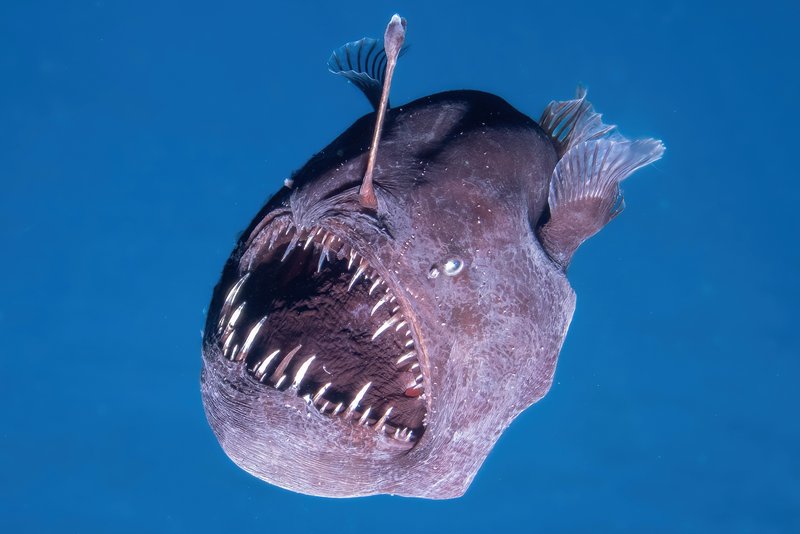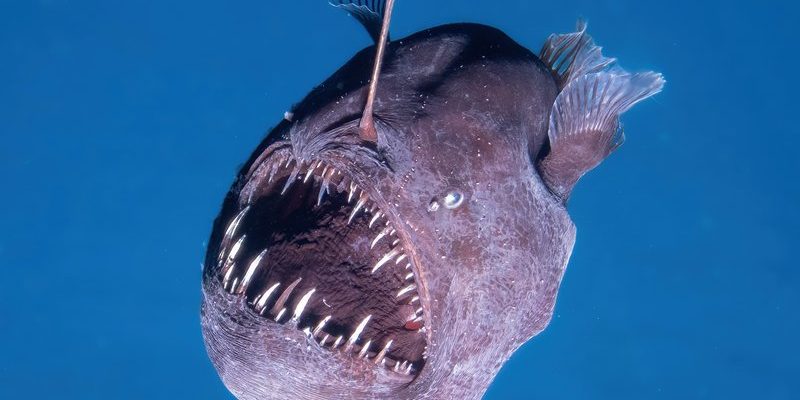
Picture yourself in the vast, dark ocean, where sunlight barely reaches. Here, among the shadowy depths, lives a creature so peculiar that it seems almost otherworldly—the Deep Sea Anglerfish. This fish is a master of survival in one of the planet’s most extreme environments. With its eerie looks and fascinating behavior, it truly holds a special place in the aquatic world.
So, what makes the Deep Sea Anglerfish such a standout? Not just its appearance, but also its remarkable adaptations. These fish have evolved to thrive in the pitch-black darkness of the deep sea, where their hunting techniques and social behaviors are nothing short of extraordinary. Let’s dive into the intriguing life of these remarkable fish and explore the wonders they possess.
What is a Deep Sea Anglerfish?
The Deep Sea Anglerfish is a unique species belonging to the family Lophiiformes. It’s most recognizable for its distinctive bioluminescent lure, which it uses to attract prey. This lure hangs from a stalk on its head, mesmerizing potential meals in the abyss. Imagine a flickering light bobbing in the dark; it’s hard to resist. And that’s exactly how this fish gets dinner!
Anglerfish come in a variety of sizes, but most are relatively small, generally ranging from about 7 to 12 inches long. However, some species can grow much larger. The difference in size, color, and shape among the various anglerfish species contributes to their diverse adaptations for survival. You might see some that are brightly colored, while others blend seamlessly into the rocky or sandy ocean floor. These features serve as camouflage, making them stealthy hunters.
Habitat and Distribution
Deep Sea Anglerfish primarily inhabit the dark depths of the ocean, often found at depths ranging from 200 meters to over 2,000 meters. This extreme habitat forms a unique ecosystem that is cold, high in pressure, and devoid of light. The anglerfish prefer these depths because they have adapted perfectly to such challenging conditions. Here, the competition for food is less fierce compared to shallower waters.
Interestingly, anglerfish are found in oceans all over the world, from the Atlantic to the Pacific. They are not picky about their surroundings, even residing around hydrothermal vents. These vents are like underwater chimneys, releasing superheated water and providing nutrients to the surrounding ecosystem. For the anglerfish, that means a hearty menu awaits just a short swim away.
Physical Characteristics
One of the most striking features of the Deep Sea Anglerfish is, of course, its bioluminescent lure. This lure can emit a soft glow, attracting curious prey like smaller fish or crustaceans. What’s fascinating is that this ability to produce light comes from specialized bacteria living in the lure, creating a perfect partnership: the fish gets a meal, and the bacteria get a cozy home!
Another notable physical trait is their wide mouths and sharp teeth, which are specially designed to capture slippery prey. When it comes time to eat, the anglerfish can open its mouth incredibly wide—like a trap snapping shut! The teeth are angled backward, ensuring that once prey is inside, it has little chance of escaping.
Diet and Feeding Habits
The Deep Sea Anglerfish is a carnivore, primarily feeding on smaller fish, squid, and crustaceans. Their feeding strategy is an impressive blend of patience and efficiency. They can sit in the shadows, waiting for unsuspecting prey to come close. When the lure does its job, and a fish is drawn in, the anglerfish strikes with lightning speed!
Once the prey gets too close, the anglerfish can use its expandable stomach to consume meals that are much larger than its own head! This ability to eat prey that size is essential for survival in the deep sea, where food sources can be scarce. Essentially, every meal counts!
Reproduction and Lifespan
Reproduction among Deep Sea Anglerfish is particularly fascinating. Males and females do not always look alike. In fact, males are often much smaller than females and have a unique role. When they find a female, they latch onto her with their sharp teeth and essentially become a permanent part of her body, sharing nutrients and hormones. This symbiotic relationship ensures that both partners have a better chance of reproduction in the harsh environment.
The lifespan of anglerfish varies among species, but many can live up to 10 years or more. However, due to their remote habitats and the difficulties in studying them, much about their life cycles remains a mystery. Scientists are continually learning about their biology, behavior, and life history, unveiling new secrets from the deep.
Table of Interesting Facts
| Common Name: | Deep Sea Anglerfish |
| Size: | 7 to 12 inches (some species larger) |
| Habitat: | 200 to 2,000 meters deep in oceans worldwide |
| Diet: | Carnivore (smaller fish, squid, crustaceans) |
| Reproduction: | Males latch onto females permanently |
| Lifespan: | Up to 10 years or more |
Conservation Status
Understanding the conservation status of the Deep Sea Anglerfish is tricky due to their remote habitats and the lack of research. Many deep-sea species, including anglerfish, face potential threats from deep-sea mining and climate change. The effects of rising ocean temperatures and acidification can impact their food sources and habitats.
Although not currently classified as endangered, the vulnerability of their ecosystems means researchers advocate for monitoring these creatures. Protecting the deep-sea environment is essential. By ensuring that these ecosystems thrive, we help preserve the fascinating life forms that inhabit them, including the Deep Sea Anglerfish.
The Deep Sea Anglerfish is an extraordinary example of evolution’s creativity in the ocean depths. With its captivating lure, impressive hunting abilities, and unique reproductive strategies, it inspires curiosity and awe. As we continue to explore our planet’s oceans, it’s crucial to protect such unique species that are perfectly adapted to their environments, reminding us of the vast wonders our world holds.
FAQ
What is the main purpose of the anglerfish’s lure?
The anglerfish’s lure serves primarily as a bait to attract prey. The bioluminescent glow draws in curious fish, making them an easy target for the anglerfish. This clever adaptation of using light is key to their hunting strategy in the dark depths where they live.
Are all anglerfish bioluminescent?
Not all anglerfish species are bioluminescent. However, many do possess this remarkable feature to aid in hunting. Species that reside in deeper waters are more likely to have developed bioluminescence due to the absence of sunlight, making it a critical adaptation for survival.
How do anglerfish fit into their ecosystem?
Anglerfish are crucial components of their ecosystems. They help maintain the balance of marine life by preying on smaller fish and invertebrates. Their role as predators helps control populations of their prey, contributing to the overall health of the marine food web.
What do anglerfish look like?
Deep Sea Anglerfish have a distinctive appearance, characterized by their wide mouths, sharp teeth, and the unique lure atop their heads. They often have a somewhat grotesque look, which helps keep them camouflaged against the ocean floor. Their colors can vary, but many are dark, aiding in their stealthy behavior.
How many species of anglerfish exist?
There are over 200 known species of anglerfish, each with its unique adaptations and characteristics. These species vary significantly in size, appearance, and habitat preferences, showcasing the diversity within this fascinating group of fish.
Can you keep anglerfish in an aquarium?
Keeping anglerfish in an aquarium is quite challenging due to their specialized diet and habitat requirements. They need specific conditions that mimic their deep-sea environment. While technically possible, it requires a significant amount of knowledge and resources, making it impractical for most hobbyists.
Do anglerfish have any natural predators?
Adult Deep Sea Anglerfish have few natural predators due to their deep-water habitat. However, young anglerfish may be at risk from larger fish and other predators. These fish have specialized adaptations for avoiding predation, such as camouflage and deep dwelling, which help them evade many threats.
Why are deep-sea fish hard to study?
Deep-sea fish, like the anglerfish, are difficult to study due to their remote habitats. The extreme conditions of high pressure, cold temperatures, and complete darkness make exploration challenging. Additionally, collecting specimens for research is logistically complex and costly, leaving many aspects of their biology still unknown.
What adaptations help anglerfish survive in deep water?
Anglerfish have several adaptations that allow them to thrive in extreme deep-sea environments. Their bioluminescent lure aids in attracting prey, while their expandable stomachs enable them to consume large meals. Furthermore, their dark coloration helps them blend into the ocean floor, making hunting more effective and reducing predation risks.
How does climate change affect deep-sea ecosystems?
Climate change impacts deep-sea ecosystems in various ways, including rising ocean temperatures and acidification. These changes can disrupt food sources, alter habitats, and affect the delicate balance of marine life. As changes occur, creatures like the Deep Sea Anglerfish may face challenges that threaten their survival.

